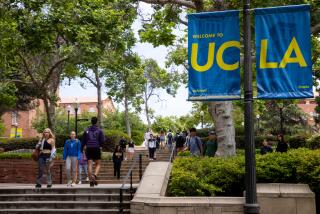New UC San Diego Faculty Makes Impressive Lineup : Design: Selections by the dean of the new architecture school promise to help change the direction of teaching.
SAN DIEGO — In her most significant act yet as dean of the new architecture school at UC San Diego, Adele Santos has selected four founding faculty members who promise to help her reshape architectural education for the 1990s.
Since being appointed dean in July, 1990, Santos has said that the school will head in innovative directions, with low-cost housing, diverse research and a multicultural approach to architectural history among her highest priorities.
The new faculty members were selected by Santos and a university search committee from a field of 435 applicants, including about 100 who were genuinely qualified for the jobs, Santos said. The quartet will give the school a broad base of knowledge and experience:
* William Curtis, 43, is one of the most respected architectural historians in the world. Santos finds him especially appealing because of his interest in the architecture of varied cultures.
His book “Modern Architecture Since 1900” is standard issue for architecture students, and he has also written extensively about architects, from Le Corbusier to Le Corbusier’s one-time disciple, Indian architect Balkrishna Doshi.
* Dana Cuff, 38, teaches and writes prodigiously about sociological aspects of architecture. She met Santos when both were on the faculty at Rice University during the early 1980s.
Cuff’s new book, “Architecture: The Story of Practice,” concludes with recommendations for overhauling architectural education. Above all, she believes architects need better preparation for the close scrutiny their projects now face from elected officials, city planners and community design review boards.
“In my mind, the most interesting development is something I would call the social art of design,” Cuff said. “Architecture now is made out of a political process, not the ideas of the individual alone. To learn to work creatively within this process is critical to the next generation of architects.”
* Craig Hodgetts, 54, a frequent guest lecturer at the University of Pennsylvania during the late 1980s, when Santos was chairman of the architecture department there, is by far the most prolific designer on the new faculty.
His work includes not only buildings but museum exhibits, stage sets, furniture, trade-show booths and even a collaborative exhibit with science fiction writer William Gibson at the San Francisco Museum of Modern Art last year.
Hodgetts and his partner and wife, Ming Fung, are also at work designing a nighttime entertainment district for Tokyo Disneyland.
* Susan Ubbelohde has a lengthy list of credits for her research and writings on the energy-conserving aspects of design. It’s impressive that Santos placed ecology high enough on her agenda that she selected Ubbelohde as a founding faculty member.
“I think these are all rather unique people,” Santos said. “I was looking for people who had taken kind of an unusual route to get where they were, who hadn’t simply assumed a conventional career. I think in each one of them there’s some kind of interesting twist to the normal pattern.
“Ithink they are all adventurous. I think they’ve all had some kind of independent way of thinking. I think they all understand the pitfalls of current architectural education. It hasn’t evolved much over the last few decades, at a time when the world around us has evolved tremendously.”
All four new professors already have busy careers and lives elsewhere.
Curtis lives in southern France and visits the United States often to lecture at several universities. Cuff is a professor at USC. Her husband, Kevin Daly, will relocate his architectural practice to San Diego.
Ubbelohde is leaving a professorship at the University of Minnesota. Hodgetts will move a thriving design practice to San Diego; he spoke with enthusiasm about building a house here, possibly on one of the finger canyons near downtown.
Eventually, the architecture school will have its own new building on campus. Several sites are being considered, but Santos said it may take five or six years before a building is completed. It’s possible she and her staff will team up on its design.
About the only surprising thing about the four appointees is that none are from South America, the Far East or a Third World country. Santos has strong ties to architects in many nations, has spoken often of her desire to establish what she calls a new “north-south” architectural network through the Americas, and has already invited several of these foreign architects to speak at UCSD.
But Santos dismisses this criticism, saying that architects from all over the world will come to the school often as guest lecturers, and that it would be impractical for many of them to move to San Diego permanently.
Besides the four appointees, the architecture school has selected two San Diego-based adjunct faculty members: architect Rob Quigley and landscape architect Ignacio Bunster-Ossa.
Hodgetts and Curtis are joining the faculty this fall, Cuff and Ubbelohde in January. Hodgetts and Curtis will work two-thirds time, Cuff and Ubbelohde full time.
The fact that all four are willing to abandon other, viable careers for UCSD speaks highly of their expectations for the new school, and of their respect for Santos.
Curtis and Ubbelohde were unavailable for comment, but Hodgetts and Cuff both said they were drawn to UCSD by the opportunity to start a new, alternative architecture program from scratch.
“I’m thrilled,” Cuff said. “I think it’s going to be the most exciting thing I’ve ever done.”
Added Hodgetts: “A few years ago, when the first drafts of plans for the new school were being circulated, an acquaintance of mine in San Diego sent much of the material up to me for my comment,” he said, referring to early groundwork laid by a steering committee that included San Diego architects Quigley, Bob Mosher, Joe Martinez and Frank Hope Jr.
“I was excited by what I read,” Hodgetts said. “The world has changed. It’s an information-rich, pluralistic culture, which means an increasingly synthesizing role for architecture, as opposed to an isolated monumental role.”
(All of the new faculty members will participate in an architecture forum at UCSD on Nov. 16 and 17, exploring the relationship between architecture and other disciplines, such as technology, film and design.)
Hodgetts’ first class at UCSD next fall will be an environmental communications laboratory.
“The mission for the lab is to enhance the ability of architects to receive information from (a project’s) context--the community, ecology, technology. Secondly, we want to aid and abet designers in communicating with the clients, communities and agencies around them.”
Hodgetts also indicated some directions that Santos’ high-priority research may take.
“Adele and I and the rest of the faculty are very much agreed that research should really be directed in an applied way, but it should not be simply the design of a particular building in a particular location. What we’d be looking for would be prototypical situations--how to provide infrastructure for do-it-yourself housing in a favella type environment, a shanty town; how to get waste products out, provide energy, et cetera.
“The research agenda could include low-cost housing, disaster relief housing--that could become the prime focus.
“Part of the program for the school is a strong internal research group which might work on a consulting basis to government or nonprofit agencies to develop prototypes in housing, or computer software which would enhance an architect’s ability to design, or we might get involved in community planning.”
Santos thinks of her founding faculty as a tight-knit group that might even enter architectural competitions together.
“I’m hopefully going to enter a competition with my new colleagues for the development of 58 acres in an area south of Kobe, Japan,” she said. “This new community is seen as experimental--affordable, self-sufficient, with extensive recycling. My idea is to do this with Craig Hodgetts and Susan Ubbelohde as a gearing-up exercise for other things.
“It’s relatively rare for a faculty to collaborate, but it would be healthy for us. If we could win this thing, there’s no end to the work that could be done.”
More to Read
The biggest entertainment stories
Get our big stories about Hollywood, film, television, music, arts, culture and more right in your inbox as soon as they publish.
You may occasionally receive promotional content from the Los Angeles Times.










